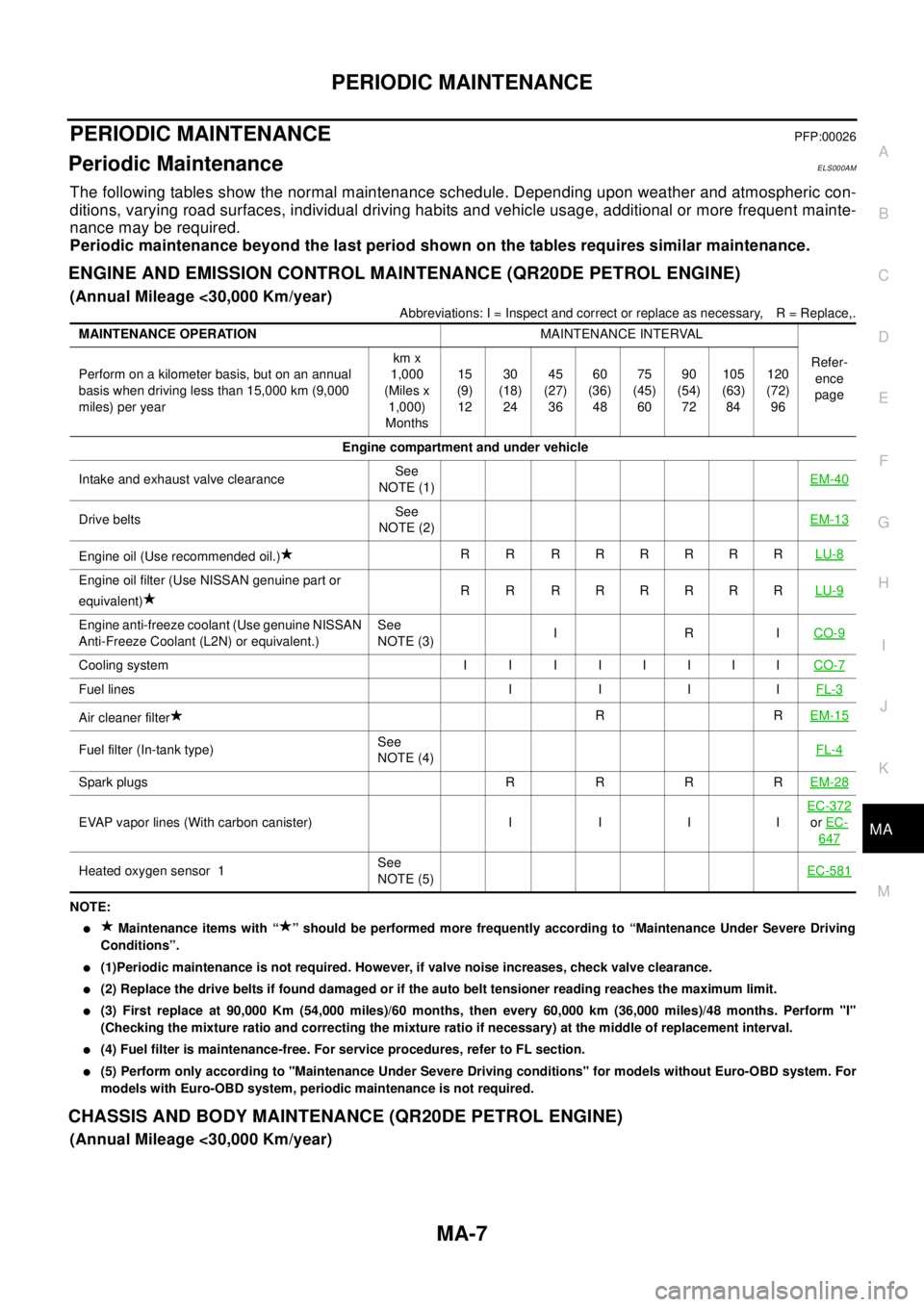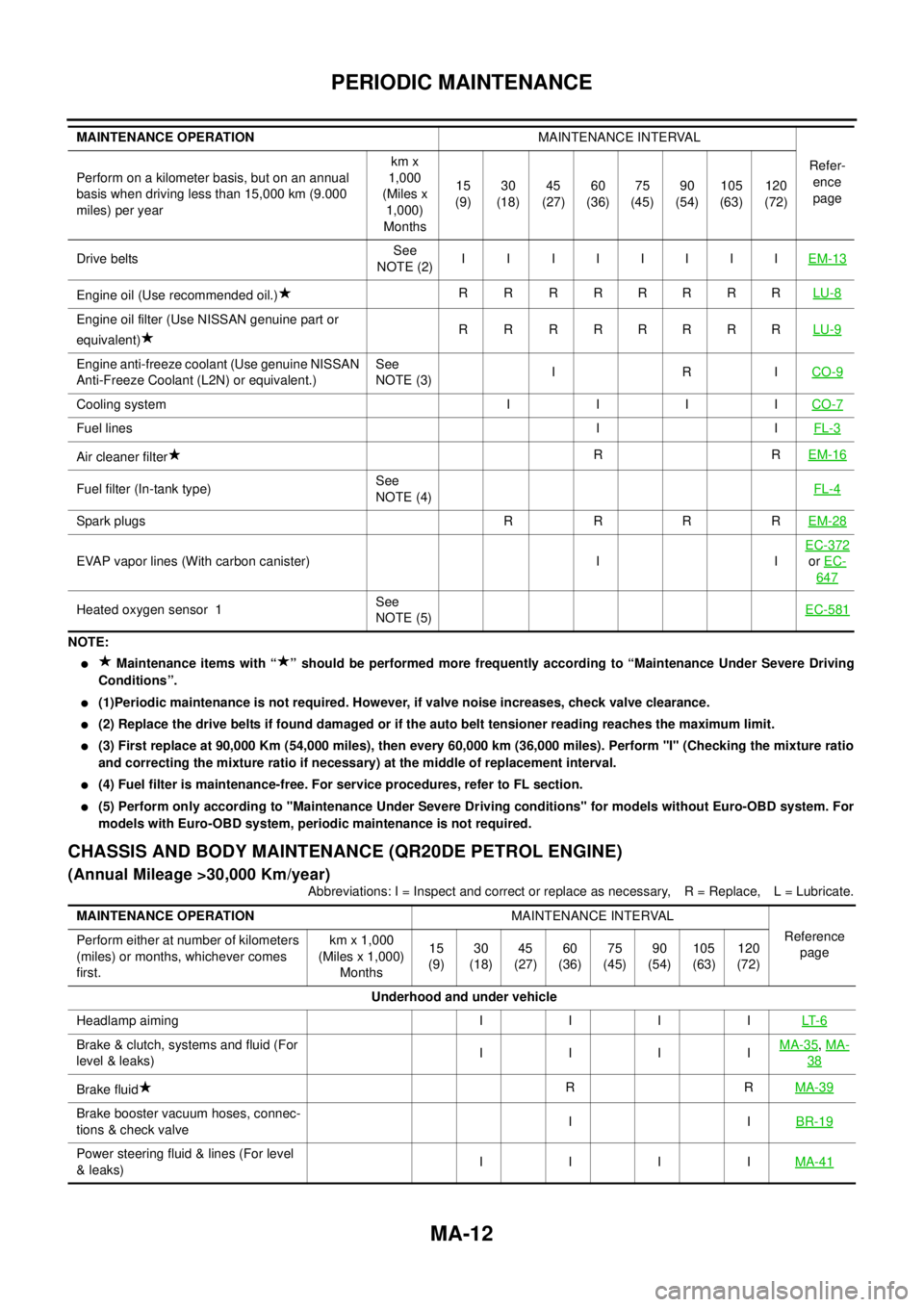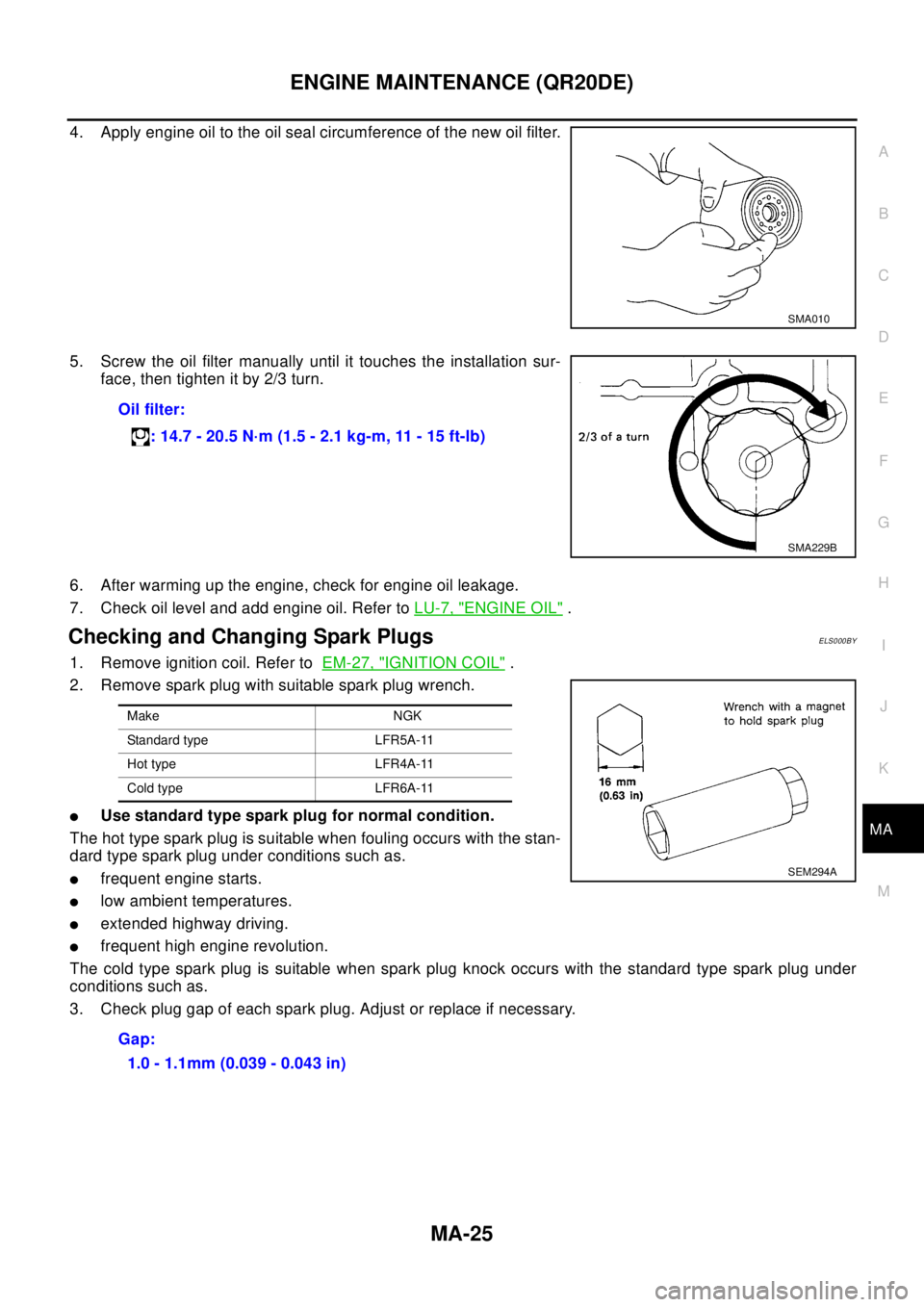2003 NISSAN X-TRAIL spark plugs replace
[x] Cancel search: spark plugs replacePage 1171 of 3066
![NISSAN X-TRAIL 2003 Electronic Repair Manual TROUBLE DIAGNOSIS
EC-57
[QR (WITH EURO-OBD)]
C
D
E
F
G
H
I
J
K
L
MA
EC
TROUBLE DIAGNOSISPFP:00004
Trouble Diagnosis IntroductionEBS00BMH
INTRODUCTION
The engine has an ECM to control major systems suc NISSAN X-TRAIL 2003 Electronic Repair Manual TROUBLE DIAGNOSIS
EC-57
[QR (WITH EURO-OBD)]
C
D
E
F
G
H
I
J
K
L
MA
EC
TROUBLE DIAGNOSISPFP:00004
Trouble Diagnosis IntroductionEBS00BMH
INTRODUCTION
The engine has an ECM to control major systems suc](/manual-img/5/57402/w960_57402-1170.png)
TROUBLE DIAGNOSIS
EC-57
[QR (WITH EURO-OBD)]
C
D
E
F
G
H
I
J
K
L
MA
EC
TROUBLE DIAGNOSISPFP:00004
Trouble Diagnosis IntroductionEBS00BMH
INTRODUCTION
The engine has an ECM to control major systems such as fuel con-
trol, ignition control, idle air control system, etc. The ECM accepts
input signals from sensors and instantly drives actuators. It is essen-
tial that both input and output signals are proper and stable. At the
same time, it is important that there are no problems such as vac-
uum leaks, fouled spark plugs, or other problems with the engine.
It is much more difficult to diagnose a problem that occurs intermit-
tently rather than continuously. Most intermittent problems are
caused by poor electric connections or improper wiring. In this case,
careful checking of suspected circuits may help prevent the replace-
ment of good parts.
A visual check only may not find the cause of the problems. A road
test with CONSULT-II (or GST) or a circuit tester connected should
be performed. Follow the “Work Flow” onEC-58
.
Before undertaking actual checks, take a few minutes to talk with a
customer who approaches with a driveability complaint. The cus-
tomer can supply good information about such problems, especially
intermittent ones. Find out what symptoms are present and under
what conditions they occur. A “Diagnostic Worksheet” like the exam-
ple onEC-61
should be used.
Start your diagnosis by looking for “conventional” problems first. This
will help troubleshoot driveability problems on an electronically con-
trolled engine vehicle.
MEF036D
SEF233G
SEF234G
Page 1323 of 3066
![NISSAN X-TRAIL 2003 Electronic Repair Manual DTC P0300 - P0304 MULTIPLE CYLINDER MISFIRE, NO. 1 - 4 CYLINDER MIS-
FIRE
EC-209
[QR (WITH EURO-OBD)]
C
D
E
F
G
H
I
J
K
L
MA
EC
5.CHECK IGNITION SPARK
1. Disconnect ignition coil assembly from rocker NISSAN X-TRAIL 2003 Electronic Repair Manual DTC P0300 - P0304 MULTIPLE CYLINDER MISFIRE, NO. 1 - 4 CYLINDER MIS-
FIRE
EC-209
[QR (WITH EURO-OBD)]
C
D
E
F
G
H
I
J
K
L
MA
EC
5.CHECK IGNITION SPARK
1. Disconnect ignition coil assembly from rocker](/manual-img/5/57402/w960_57402-1322.png)
DTC P0300 - P0304 MULTIPLE CYLINDER MISFIRE, NO. 1 - 4 CYLINDER MIS-
FIRE
EC-209
[QR (WITH EURO-OBD)]
C
D
E
F
G
H
I
J
K
L
MA
EC
5.CHECK IGNITION SPARK
1. Disconnect ignition coil assembly from rocker cover.
2. Connect a known good spark plug to the ignition coil assembly.
3. Place end of spark plug against a suitable ground and crank engine.
4. Check for spark.
OK or NG
OK >> GO TO 6.
NG >> Check ignition coil, power transistor and their circuits.
Refer toEC-334, "
IGNITION SIGNAL".
6.CHECK SPARK PLUGS
Remove the spark plugs and check for fouling, etc.
OK or NG
OK >> GO TO 7.
NG >> Repair or replace spark plug(s) with standard type
one(s). For spark plug type, refer toMA-25, "
Checking
and Changing Spark Plugs".
7.CHECK COMPRESSION PRESSURE
Check compression pressure. Refer toEM-52, "
CHECKING COMPRESSION PRESSURE".
OK or NG
OK >> GO TO 8.
NG >> Check pistons, piston rings, valves, valve seats and cylinder head gaskets.
8.CHECK FUEL PRESSURE
1. Install all removed parts.
2. Release fuel pressure to zero. Refer toEC-34, "
FUEL PRESSURE RELEASE".
3. Install fuel pressure gauge and check fuel pressure. Refer toEC-34, "
FUEL PRESSURE CHECK".
OK or NG
OK >> GO TO 9.
NG >> Follow the construction of "FUEL PRESSURE CHECK".
SEF575Q
SEF156I
Standard:
1,190 kPa (11.9 bar, 12.1 kg/cm2, 172 psi)/250
rpm
Minimum:
990 kPa (9.9 bar, 10.1 kg/cm
2, 144 psi)/250 rpm
Difference between each
cylinder:98 kPa (0.98 bar, 1.0 kg/cm
2, 14 psi)/250 rpm
At idle: Approx. 350 kPa (3.5 bar, 3.7 kg/cm
2,51psi)
Page 1521 of 3066
![NISSAN X-TRAIL 2003 Electronic Repair Manual TROUBLE DIAGNOSIS
EC-407
[QR (WITHOUT EURO-OBD)]
C
D
E
F
G
H
I
J
K
L
MA
EC
TROUBLE DIAGNOSISPFP:00004
Trouble Diagnosis IntroductionEBS00BMU
INTRODUCTION
The engine has an ECM to control major systems NISSAN X-TRAIL 2003 Electronic Repair Manual TROUBLE DIAGNOSIS
EC-407
[QR (WITHOUT EURO-OBD)]
C
D
E
F
G
H
I
J
K
L
MA
EC
TROUBLE DIAGNOSISPFP:00004
Trouble Diagnosis IntroductionEBS00BMU
INTRODUCTION
The engine has an ECM to control major systems](/manual-img/5/57402/w960_57402-1520.png)
TROUBLE DIAGNOSIS
EC-407
[QR (WITHOUT EURO-OBD)]
C
D
E
F
G
H
I
J
K
L
MA
EC
TROUBLE DIAGNOSISPFP:00004
Trouble Diagnosis IntroductionEBS00BMU
INTRODUCTION
The engine has an ECM to control major systems such as fuel con-
trol, ignition control, idle air control system, etc. The ECM accepts
input signals from sensors and instantly drives actuators. It is essen-
tial that both input and output signals are proper and stable. At the
same time, it is important that there are no problems such as vac-
uum leaks, fouled spark plugs, or other problems with the engine.
It is much more difficult to diagnose a problem that occurs intermit-
tently rather than continuously. Most intermittent problems are
caused by poor electric connections or improper wiring. In this case,
careful checking of suspected circuits may help prevent the replace-
ment of good parts.
A visual check only may not find the cause of the problems. A road
test with CONSULT-II (or GST) or a circuit tester connected should
be performed. Follow the “Work Flow” onEC-408
.
Before undertaking actual checks, take a few minutes to talk with a
customer who approaches with a driveability complaint. The cus-
tomer can supply good information about such problems, especially
intermittent ones. Find out what symptoms are present and under
what conditions they occur. A “Diagnostic Worksheet” like the exam-
ple onEC-410
should be used.
Start your diagnosis by looking for “conventional” problems first. This
will help troubleshoot driveability problems on an electronically con-
trolled engine vehicle.
MEF036D
SEF233G
SEF234G
Page 2499 of 3066

PERIODIC MAINTENANCE
MA-7
C
D
E
F
G
H
I
J
K
MA
B
MA
PERIODIC MAINTENANCEPFP:00026
Periodic MaintenanceELS000AM
The following tables show the normal maintenance schedule. Depending upon weather and atmospheric con-
ditions, varying road surfaces, individual driving habits and vehicle usage, additional or more frequent mainte-
nance may be required.
Periodic maintenance beyond the last period shown on the tables requires similar maintenance.
ENGINE AND EMISSION CONTROL MAINTENANCE (QR20DE PETROL ENGINE)
(Annual Mileage <30,000 Km/year)
Abbreviations: I = Inspect and correct or replace as necessary, R = Replace,.
NOTE:
lMaintenance items with “ ” should be performed more frequently according to “Maintenance Under Severe Driving
Conditions”.
l(1)Periodic maintenance is not required. However, if valve noise increases, check valve clearance.
l(2) Replace the drive belts if found damaged or if the auto belt tensioner reading reaches the maximum limit.
l(3) First replace at 90,000 Km (54,000 miles)/60 months, then every 60,000 km (36,000 miles)/48 months. Perform "I"
(Checking the mixture ratio and correcting the mixture ratio if necessary) at the middle of replacement interval.
l(4) Fuel filter is maintenance-free. For service procedures, refer to FL section.
l(5) Perform only according to "Maintenance Under Severe Driving conditions" for models without Euro-OBD system. For
models with Euro-OBD system, periodic maintenance is not required.
CHASSIS AND BODY MAINTENANCE (QR20DE PETROL ENGINE)
(Annual Mileage <30,000 Km/year)
MAINTENANCE OPERATIONMAINTENANCE INTERVAL
Refer-
ence
page Perform on a kilometer basis, but on an annual
basis when driving less than 15,000 km (9,000
miles) per yearkm x
1,000
(Miles x
1,000)
Months15
(9)
1230
(18)
2445
(27)
3660
(36)
4875
(45)
6090
(54)
72105
(63)
84120
(72)
96
Engine compartment and under vehicle
Intake and exhaust valve clearanceSee
NOTE (1)EM-40
Drive beltsSee
NOTE (2)EM-13
Engine oil (Use recommended oil.)R R RRRRRRLU-8
Engine oil filter (Use NISSAN genuine part or
equivalent)R R RRRRRRLU-9
Engine anti-freeze coolant (Use genuine NISSAN
Anti-Freeze Coolant (L2N) or equivalent.)See
NOTE (3)IRICO-9
Coolingsystem I I IIIIIICO-7
Fuel lines I I I IFL-3
Air cleaner filterRREM-15
Fuel filter (In-tank type)See
NOTE (4)FL-4
Spark plugs R R R REM-28
EVAP vapor lines (With carbon canister) I I I IEC-372orEC-
647
Heated oxygen sensor 1See
NOTE (5)EC-581
Page 2504 of 3066

MA-12
PERIODIC MAINTENANCE
NOTE:
lMaintenance items with “ ” should be performed more frequently according to “Maintenance Under Severe Driving
Conditions”.
l(1)Periodic maintenance is not required. However, if valve noise increases, check valve clearance.
l(2) Replace the drive belts if found damaged or if the auto belt tensioner reading reaches the maximum limit.
l(3) First replace at 90,000 Km (54,000 miles), then every 60,000 km (36,000 miles). Perform "I" (Checking the mixture ratio
and correcting the mixture ratio if necessary) at the middle of replacement interval.
l(4) Fuel filter is maintenance-free. For service procedures, refer to FL section.
l(5) Perform only according to "Maintenance Under Severe Driving conditions" for models without Euro-OBD system. For
models with Euro-OBD system, periodic maintenance is not required.
CHASSIS AND BODY MAINTENANCE (QR20DE PETROL ENGINE)
(Annual Mileage >30,000 Km/year)
Abbreviations: I = Inspect and correct or replace as necessary, R = Replace, L = Lubricate. Drive beltsSee
NOTE (2)IIIIIIIIEM-13
Engine oil (Use recommended oil.)R R RRRRRRLU-8
Engine oil filter (Use NISSAN genuine part or
equivalent)R R RRRRRRLU-9
Engine anti-freeze coolant (Use genuine NISSAN
Anti-Freeze Coolant (L2N) or equivalent.)See
NOTE (3)IRICO-9
Cooling system I I I ICO-7
Fuel linesIIFL-3
Air cleaner filterRREM-16
Fuel filter (In-tank type)See
NOTE (4)FL-4
Spark plugs R R R REM-28
EVAP vapor lines (With carbon canister) I IEC-372orEC-
647
Heated oxygen sensor 1See
NOTE (5)EC-581
MAINTENANCE OPERATIONMAINTENANCE INTERVAL
Refer-
ence
page Perform on a kilometer basis, but on an annual
basis when driving less than 15,000 km (9.000
miles) per yearkm x
1,000
(Miles x
1,000)
Months15
(9)30
(18)45
(27)60
(36)75
(45)90
(54)105
(63)120
(72)
MAINTENANCE OPERATIONMAINTENANCE INTERVAL
Reference
page Perform either at number of kilometers
(miles) or months, whichever comes
first.km x 1,000
(Miles x 1,000)
Months15
(9)30
(18)45
(27)60
(36)75
(45)90
(54)105
(63)120
(72)
Underhood and under vehicle
Headlamp aiming I I I ILT- 6
Brake & clutch, systems and fluid (For
level & leaks)IIIIMA-35,MA-
38
Brake fluidRRMA-39
Brake booster vacuum hoses, connec-
tions & check valveIIBR-19
Power steering fluid & lines (For level
&leaks)IIIIMA-41
Page 2517 of 3066

ENGINE MAINTENANCE (QR20DE)
MA-25
C
D
E
F
G
H
I
J
K
MA
B
MA
4. Apply engine oil to the oil seal circumference of the new oil filter.
5. Screw the oil filter manually until it touches the installation sur-
face, then tighten it by 2/3 turn.
6. After warming up the engine, check for engine oil leakage.
7. Check oil level and add engine oil. Refer toLU-7, "
ENGINE OIL".
Checking and Changing Spark PlugsELS000BY
1. Remove ignition coil. Refer toEM-27, "IGNITION COIL".
2. Remove spark plug with suitable spark plug wrench.
lUse standard type spark plug for normal condition.
The hot type spark plug is suitable when fouling occurs with the stan-
dard type spark plug under conditions such as.
lfrequent engine starts.
llow ambient temperatures.
lextended highway driving.
lfrequent high engine revolution.
The cold type spark plug is suitable when spark plug knock occurs with the standard type spark plug under
conditions such as.
3. Check plug gap of each spark plug. Adjust or replace if necessary.
SMA010
Oil filter:
: 14.7 - 20.5 N·m (1.5 - 2.1 kg-m, 11 - 15 ft-lb)
SMA229B
Make NGK
Standard type LFR5A-11
Hot type LFR4A-11
Cold type LFR6A-11
Gap:
1.0 - 1.1mm (0.039 - 0.043 in)
SEM294A